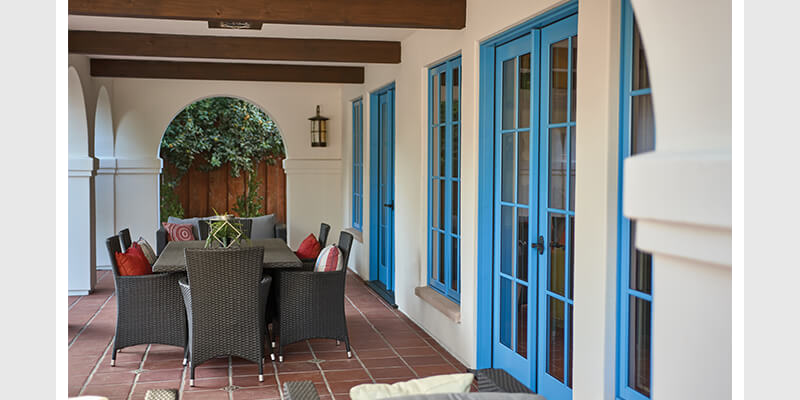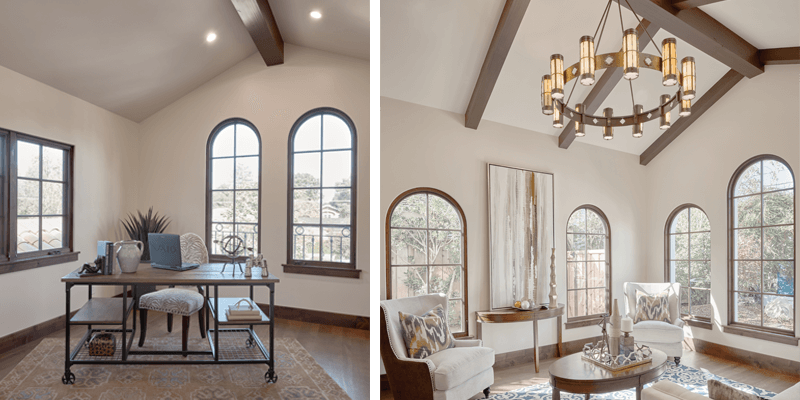The site's constraints led Timeline to find inspiration in the covered porches and enclosed courtyards of Spanish Mission style, so they positioned the dining room in the heart of the home and added as much natural light as possible. Erasing the boundaries between indoors and outdoors, Kolbe's Ultra Series windows and doors surround the family with light, fresh air and views, and extend the living space onto the loggia and into the yard. Upon reflection, Harrigan called the dining room "one of the most fun parts of the house. When you stand on the upper level balcony and look down, you feel a great sense of connectivity between the two floors and across the whole home."
"Spanish Mission architectural styles, of which the California Mission is one, may be the least articulated or flamboyant of all styles from the colonial legacy," explains architect Ope Tani of Timeline. Attributed to the Spanish chapels and missions of the late 1700s to early 1800s, the design and construction of these structures took shape in an era before standard 2-by-4s and expansive areas of glass were available.
"Traditionally, windows and doors are without the trim pieces, so the cement, plaster or stucco is returned to the framing of the opening. This is true for interior and exterior finishing for windows and doors," continued Tani. "The effect of articulating some window headers on the exterior is actually a Pueblo influence that became prevalent over time. The elaborate frills typical of colonial French, English and Dutch openings are omitted in the Mission language. This resulting 'simple' look is well supported by the idea of exposing the wood rafter tails."
Adding to this description, James noted, "We wanted to be true to the Spanish Mission Revival style. We're not trying to be trendy. We wanted a classic, timeless style. The flow of the house feels modern, but the style looks like it's early 20th Century. We were deliberate in choosing the details – exterior treatments, windows, tiles, the color of the floors and walls – to create a cohesive look. We haven't seen a house like ours, particularly any newly constructed homes."

James and Jessica's new home respectfully reflects these traditional characteristics with oak floors, custom wrought iron rails, exposed wood beam ceilings, curved archways and a red clay tile roof. The style-defining white stucco walls seem to hug the Kolbe windows and doors, which pop with color in a custom bright blue extruded aluminum exterior finish. "The windows were a very important part of our home's design and they needed to look right," James emphasized. "When you’re designing a home to a certain architectural period, the wrong style of window throws everything off. We were careful to keep our windows with a vertical orientation. They are either square or tall – not wide like a ranch house. They also have the traditional look of smaller, separate panes within the window."
The windows were a very important part of our home's design and they needed to look right. When you’re designing a home to a certain architectural period, the wrong style of window throws everything off.

Custom designed to mimic the aesthetic of classic, single-pane, true divided lites, the windows and doors provide comfort and energy efficiency with performance divided lites and high-performance insulated glass. Alder wood interiors add warmth to the home, while radius windows that open like casements add ventilation to architectural authenticity.
Other sustainability features in the home’s design and construction include solar panels to produce electricity for cooking, HVAC and lighting. "In California, we are always green by law," said Harrigan. He added. "Kolbe offers high-end windows and doors with the sizing, customization and reliability we need. We count on Kolbe and on our local dealer, Murray Window & Door, for all of our custom homes."
As their name indicates, Timeline relies on a design-build process to create each custom home. “Having design-build allows us to review together with the homeowner all the details and keep on track and in alignment.” Harrigan elaborated, "Design-build is a state of mind and not a company. ...The mindset is key – we will work together to ensure we are all on the same page."